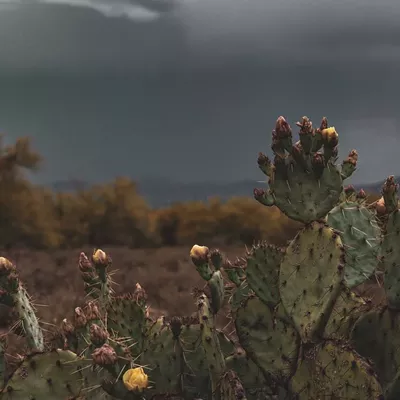It's "better to chase as a team," the pair cautions in their artists' statement at Etherton Gallery, where they have the electrifying show Out of a Clear Blue Sky: Severe Weather Photography. "At least one of us would see that huge bolt when the other one was looking down at his camera or loading a roll of film in the car."
That doesn't mean they haven't had near-misses. Out at Sells, on Tohono O'odham land one fiery evening in the early '90s, a bolt struck the ground less than 200 feet away from where they were standing. Smith recounts that suddenly his hair stood up on end, electrified by the ambient charge. Willett called out to his friend, "You're dead! You're dead!" He wasn't, as it happened, and the two jumped in their car to safety, but not before they'd recorded the lightning zap on film.
"Close Call in Sells, Arizona" is Smith's version. Rolled out horizontally, the orange-red sunset is a narrow strip of sky squeezed between the dark desert below and the storm clouds above. Two bolts of lightning ricochet up and down from the ground at right, one of them thick--and way too close. Willett's "Oranging Sky, Sells" is a vertical shot of the same thing, but even closer and scarier. You can see the branches of lightning shooting off the main zig-zags, and that thick bolt looks near enough to sizzle human skin.
Primarily commercial photographers, the two men met 25 years ago in a class at Pima Community College, where they studied under Louis Carlos Bernal and Jeffrey Muir Hamilton. For much of the time since, they've been monsoon junkies, scanning the skies on Tucson summer afternoons for signs of lightning. (Willett published his first lightning shot in the Tucson Citizen, where he was a staff photog, in 1983.)
"Only three components make up a good storm," he advises in his notes, "moisture, wind and heat; if you get a perfect mixture of these ingredients, you will have something to shoot at the end of the day."
Such as the white lightning, surrounded by shimmering violet, that erupted south of Tucson one evening in 1994. In his "Lightning, Titan Missile Silo," the silo is barely visible below the extreme drama in the big sky above. (The earth is almost always dwarfed by celestial pyrotechnics in these pictures.) Two enormous bolts, branching out into an infinity of small offshoots, blaze side by side in the night sky. At left, the purple light explodes behind the white streaks.
Smith shot a cataclysm at least as dramatic north of Tucson in 1988 in "Picacho Illumination, Arizona." In the big sky above Picacho's distinctive peak, five spectacular lightning bolts surge in a row, splintering into a zillion fragments. The sky and earth are a sepia brown, lit up by a dangerous-looking yellow.
Part of the fun of this big show, some 28 photos strong, lies in its images of the familiar landscape around Tucson. Windy Point, Pusch Ridge and the Rincons all get their hour upon the electrified stage. In Willett's "Black Saguaro, Electric Sky," 1998, the trademark cactuses are etched against a blaze of blue and white sky, and a backdrop of twilight Tucson. "Cross, Arizona," 1991, by Smith, conjures up the region's Hispanic/Catholic heritage. Damaged--perhaps by lightning--the hardy cross remains standing, even as lightning bursts in a corona all around it. Smith's "Red Rock Power Station, Arizona," 2003, wonderfully captures lightning charges igniting above electrical towers, ironically pairing nature's work with humans'.
Sometimes the pictures document changes in the land over the last quarter-century. Willett's "Lightning at Dusk, Windy Point," a 1983 photo shot at the popular overlook in the Catalinas, shows the lights of Tucson glowing green at dusk. A couple of lightning bolts slice through a dark cloud in the distance. But the photographer attributes the brilliant orange of the sunset not to nature's own palette but to industrial pollution. He writes that the "three copper smelters (that) were in full production in the Southern Arizona desert" at the time spewed microscopic dust particulates into the air, creating a terrible beauty.
Smith's "Sea of Cortez, Mexico," 1998, is a relatively rare shot of lightning over water. Smith recounts that he had three cameras set up, two aimed at Rocky Point and one at the sea. He managed to "photograph some of the first bolts touching the water. I love the lightning at the beginning of the storm because I believe it looks clearer before the rain blurs them. This photograph is one of my favorites." It's a classic of purple sky, white lightning, glimmering water and a diagonal swathe of dark beach.
Willett grew up in Tucson, but spent the earliest years of his life in suburban Chicago, where he remembers sleeping in the basement with his family during midnight tornado warnings. One time, a tornado smashed into his neighborhood and damaged some houses, triggering in the small boy a "lifelong fascination with dangerous storms."
He still likes to go back to the Midwest to chase them. "Tornadic Supercell, Anthony, Kansas," 1997, explodes like an astonishing fireball, the biggest, most terrifying cloud you never hope to see, all yellow and gold, billowing up, down and sideways across the landscape. In "Gruver, Texas, Tornado," 1995, the white funnel breaks through a gray sky and murderously cascades down to the green fields below. For good measure, he's thrown in a New York shot of lightning hitting one of the Twin Towers in "Summer Storm, Lower Manhattan." It's from 1990, long before the World Trade Center was lost in human-launched fireballs.
The painterly quality of these large photos, some of them 4 feet wide, owes a debt to new technology. The pictures were originally shot on film, over a 20-year period, but they've been reprinted in sumptuous archival pigmented inkjet. The expensive machine prints large-scale, and in 12 colors, including no fewer than five blacks, according to the gallery's Terry Etherton, allowing for rich velvety blacks and brilliant purples, greens, pinks and yellows. Who knew lightning came in so many colors?
Still, the basic work remains the same. Smith's "Into the Storm, Tucson, Arizona," 1992, records just how scary the team's occupation can be. It's a road shot, with the wide blacktop narrowing to the vanishing point. The electrified road ahead is already lit up a scary yellow. The purple sky is cracked by a triple bolt of lightning, and one of its charged splinters has already made deadly contact with the road up ahead--the exact spot where the lightning photogs are headed.













